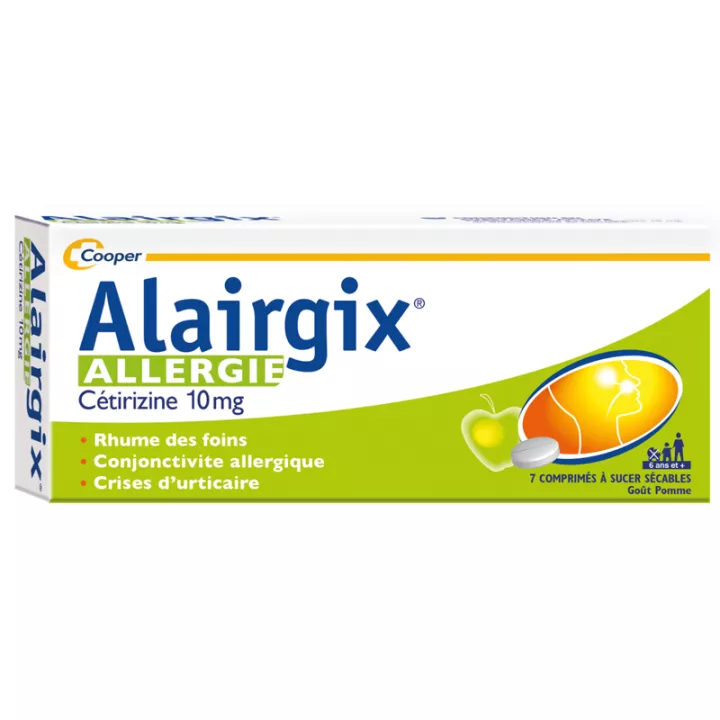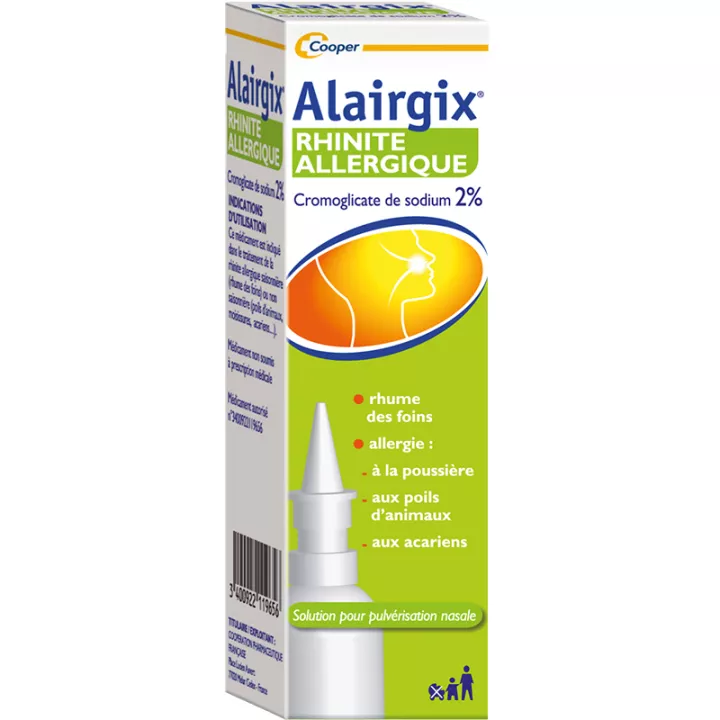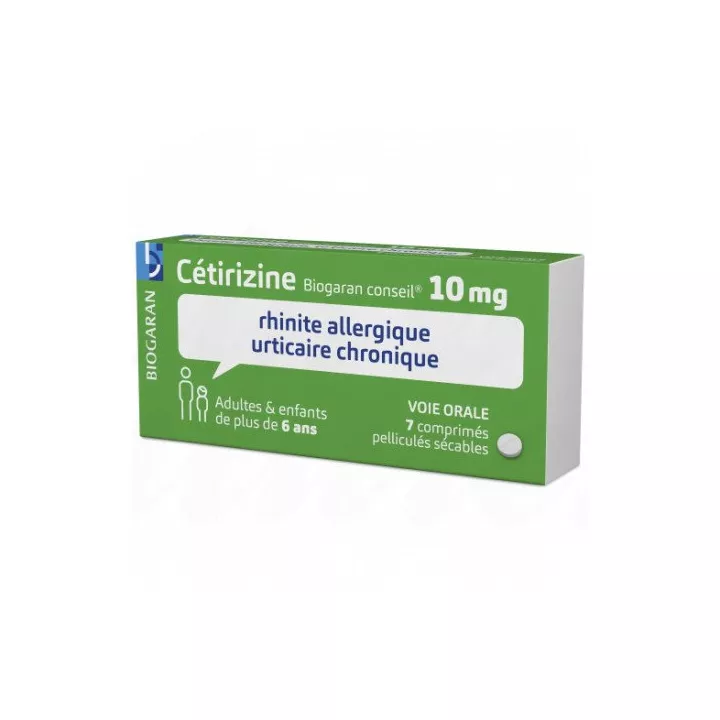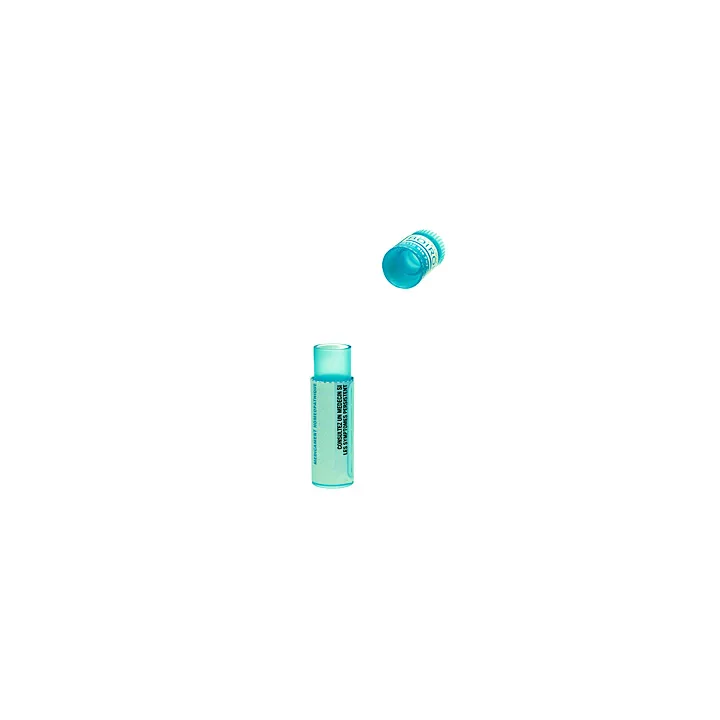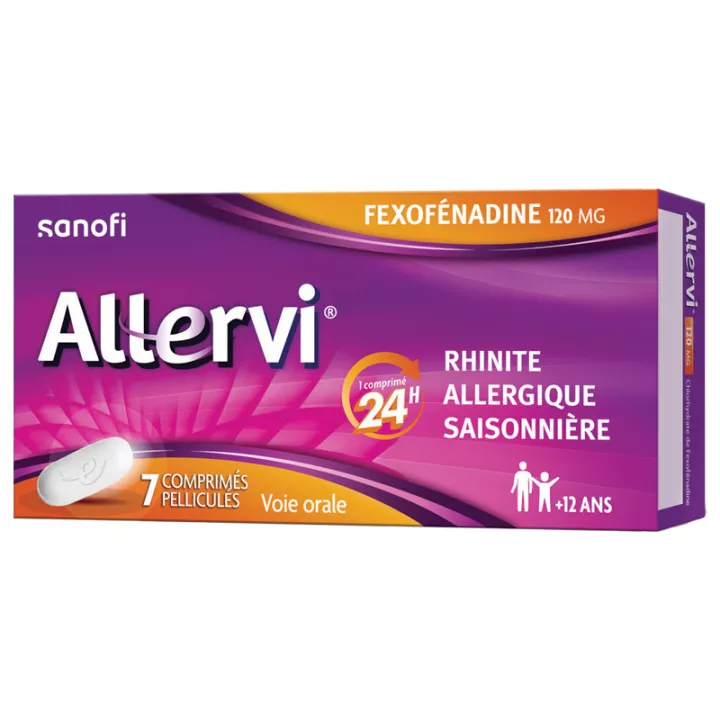NOTICE
ANSM - Last update: 23/08/2012
Name of the medicinal product
ALAIRGIX ALLERGY CETIRIZINE 10 mg, suckable tablet
Cetirizine dihydrochloride
framed
Read this leaflet carefully before you start taking this medicine. It contains important information for your treatment.
· This medication can be used in self-medication, ie used without consultation or prescription from a doctor.
· However, given its indication in the treatment of symptoms of chronic urticaria, medical advice is recommended to help you use it well, at least the first time.
· If symptoms persist after 3 days of treatment, if they become worse or if new symptoms appear, seek the advice of your pharmacist or doctor.
· This leaflet is designed to help you use this medicine. Keep there, you might need to reread it.
DO NOT LEAVE THIS MEDICINE FOR CHILDREN.
Review summary
In this notice :
1. WHAT IS ALAIRGIX ALLERGY CETIRIZINE 10 mg, suckable suckable tablet AND WHAT IT IS USED FOR?
2. BEFORE YOU TAKE ALAIRGIX ALLERGY CETIRIZINE 10 mg, tablet to suck breakable?
3. HOW TO TAKE ALAIRGIX ALLERGY CETIRIZINE 10 mg, tablet to suck breakable?
4. WHAT ARE POSSIBLE SIDE EFFECTS?
5. HOW TO STORE ALAIRGIX ALLERGY CETIRIZINE 10 mg, suckable tablet?
6. ADDITIONAL INFORMATION
1. WHAT IS ALAIRGIX ALLERGY CETIRIZINE 10 mg, suckable suckable tablet AND WHAT IT IS USED FOR?
Pharmacotherapeutic group
Cetirizine dihydrochloride is the active substance of ALAIRGIX ALLERGY CETIRIZINE.
ALAIRGIX ALLERGY CETIRIZINE is an antiallergic drug.
Therapeutic indications
In adults and adolescents over the age of 12, ALAIRGIX ALLERGY CETIRIZINE is indicated:
· for the treatment of nasal and ocular symptoms of seasonal or perennial allergic rhinitis,
· for the treatment of symptoms of chronic urticaria (idiopathic chronic urticaria).
A medical opinion is recommended for idiopathic chronic urticaria.
2. BEFORE YOU TAKE ALAIRGIX ALLERGY CETIRIZINE 10 mg, tablet to suck breakable?
List of information needed before taking the medication
Not applicable.
Cons-indications
Never take ALAIRGIX ALLERGY CETIRIZINE 10 mg tablet to be sucked in the following cases:
· if you have severe kidney disease (severe renal insufficiency with a creatinine clearance of less than 10 ml / min);
· if you are allergic to the active substance of ALAIRGIX ALLERGY CETIRIZINE or to any of the other ingredients (excipients), to hydroxyzine or to piperazine derivatives (related substances contained in other medicines).
Precautions for use; special warnings
Take special care with ALAIRGIX ALLERGY CETIRIZINE 10 mg, suckable tablet:
If you have kidney failure, seek advice from your doctor; if necessary, you should take a lower dose. The appropriate dosage will be determined by your doctor.
If you are an epileptic or if you are at risk of seizures, ask your doctor for advice.
There is no description of any interaction that may have a particular effect in the concomitant use of cetirizine (used in normal doses) and alcohol (up to a blood concentration of 0.5 per thousand corresponding to a glass of wine). As with any other antihistamine, it is nevertheless recommended to avoid taking alcohol during treatment.
Interaction with other medicines
Taking other medicines:
If you are taking or have recently taken any other medicines, including medicines obtained without a prescription, talk to your doctor or pharmacist.
Due to the profile of cetirizine, no interaction with other drugs is expected.
Interactions with food and beverages
Food and drinks
Food intake does not significantly affect the absorption of cetirizine.
Interactions with Herbal Medicines or Alternative Therapies
Not applicable.
Use during pregnancy and lactation
Pregnancy and breast feeding
Ask your doctor or pharmacist for advice before taking any medicine.
As with other medicines, the use of ALAIRGIX ALLERGY CETIRIZINE should be avoided during pregnancy.
Accidental use during pregnancy should not affect the fetus. However, it is preferable as a precautionary measure to avoid further treatment.
ALAIRGIX ALLERGY CETIRIZINE should not be taken during breast-feeding because of its passage through breast milk.
Sport
Not applicable.
Effects on ability to drive or use machines
Driving and using machines:
Clinical studies did not demonstrate impaired vigilance, reaction time or ability to drive after administration of ALAIRGIX ALLERGY CETIRIZINE at recommended doses.
If you are likely to drive a vehicle or handle a potentially hazardous tool or machine, you should not exceed the recommended dose. You should carefully evaluate your response to cetirizine treatment beforehand.
In some susceptible patients, concomitant use of alcohol or other central nervous system depressants may result in decreased attention or ability to respond.
List of excipients with known effect
Not applicable.
3. HOW TO TAKE ALAIRGIX ALLERGY CETIRIZINE 10 mg, tablet to suck breakable?
Instructions for proper use
Not applicable.
Dosage, Mode and / or route (s) of administration, Frequency of administration and Duration of treatment
How and when should you take ALAIRGIX ALLERGY CETIRIZINE
These instructions should be followed unless your doctor has given you different instructions on how to use ALAIRGIX ALLERGY CETIRIZINE.
Follow these instructions, otherwise ALAIRGIX ALLERGY CETIRIZINE may not be completely effective.
Dosage
Adults and adolescents over 12 years:
10 mg once daily or 1 tablet.
Moderate to severe renal impairment:
In patients with moderate to severe renal impairment, the dose will be reduced to 5 mg once daily and 5 mg once every two days.
If you think the effect of ALAIRGIX ALLERGY CETIRIZINE is too weak or too strong, talk to your doctor.
Administration mode
Oral use.
Place the tablet on the tongue and let it melt before swallowing.
Instruction for good use:
1. Detach a square from the blister along the pre-cut line.
2. Remove the protective film.
3. Grasp the tablet.
4. Place the tablet on the tongue and allow to dissolve.
The tablet can also be dissolved in a little water before being swallowed.
Duration of treatment
The duration of treatment depends on the type, duration and your symptoms and is determined by your doctor.
Symptoms and Instructions for Overdose
If you take more ALAIRGIX ALLERGY CETIRIZINE 10 mg, suckable tablet you should not have:
Contact your doctor if you think you have taken more tablets of ALAIRGIX ALLERGY CETIRIZINE than it should. Your doctor will decide, if necessary, what to do.
In case of overdose, the side effects described below may occur with an increased intensity. Side effects such as confusion, diarrhea, dizziness, tiredness, headache, feeling sick, pupil dilation, itching, restlessness, sedation, drowsiness, stupor, abnormal increase in heart rate, tremors and urinary retention have been reported.
Instructions for omission of one or more doses
If you forget to take ALAIRGIX ALLERGY CETIRIZINE 10 mg tablet to suck breakable:
Do not take a double dose to make up for a missed dose.
Risk of withdrawal syndrome
If you stop taking ALAIRGIX ALLERGY CETIRIZINE 10 mg tablet to suck breakable:
If you have any further questions on the use of this medication, ask your doctor or pharmacist.
4. WHAT ARE POSSIBLE SIDE EFFECTS?
Description of adverse reactions
Like all medicines, ALAIRGIX ALLERGY CETIRIZINE 10 mg, tablet to suck breakable is likely to have undesirable effects although not everyone is subject.
Since commercialization, the following adverse reactions have been reported. Their frequency was defined as: (Frequent: 1 in 100 to 1 in 10, uncommon: 1 in 1000 to 1 in 100, rare: 1 in 10,000 to 1 in 1,000, very rare: less than 1 out of 10,000).
· Blood and lymphatic system disorders:
Very rare: thrombocytopenia (decreased blood platelets)
· General condition disorders:
Common: fatigue
· Cardiac disorders:
Rare: tachycardia (heartbeat too fast)
· Eye disorders:
Very rare: disorders of accommodation, blurred vision, oculogyre crises (uncontrolled circular movements of the eyes)
· Gastrointestinal disorders:
Common: dry mouth, nausea, diarrhea
Uncommon: abdominal pain.
· General disorders and administration site conditions:
Uncommon: asthenia (extreme fatigue), malaise,
Rare: swelling (subcutaneous swelling)
· Immune system disorders:
Rare: allergic reactions, sometimes severe (very rare)
· Hepatobiliary disorders:
Rare: abnormal liver function (increased liver enzymes)
· investigations:
Rare: weight gain
· Nervous system disorders:
Common: vertigo, headache
Uncommon: paresthesia (abnormal sensation in the skin)
Rare: convulsions, abnormal movements
Very rare: syncope, tremor, dysgeusia (altered taste)
· Psychiatric disorders:
Common: somnolence
Uncommon: restlessness
Rare: aggressiveness, confusion, depression, hallucination, insomnia
Very rare: tic
· Renal and urinary disorders:
Very rare: difficulty passing urine
· Respiratory disorders:
Common: pharyngitis, rhinitis
· Skin and subcutaneous tissue disorders:
Uncommon: pruritus, rash
Rare: urticaria
Very rare: edema, fixed pigmented erythema.
If you develop any of the side effects listed above, please tell your doctor. At the first signs of allergic reaction, stop taking ALAIRGIX ALLERGY CETIRIZINE. Your doctor will assess the severity and decide what to do if necessary.
If you experience any side effects not listed in this leaflet, please tell your doctor or pharmacist.
5. HOW TO STORE ALAIRGIX ALLERGY CETIRIZINE 10 mg, suckable tablet?
Keep out of the reach and sight of children.
Expiration date
Do not use ALAIRGIX ALLERGY CETIRIZINE 10 mg, suckable tablet after the expiry date stated on the carton and blister.
Storage conditions
No special storage conditions.
If necessary, warnings against visible signs of deterioration
Medicines should not be disposed of via wastewater or household waste. Ask your pharmacist what to do with unused medications. These measures will help protect the environment.
6. ADDITIONAL INFORMATION
Full list of active substances and excipients
What contains ALAIRGIX ALLERGY CETIRIZINE 10 mg, tablet to suck breakable?
The active substance of ALAIRGIX ALLERGY CETIRIZINE is cetirizine dihydrochloride. One tablet to be sucked contains 10 mg of cetirizine dihydrochloride.
The other components are:
Betadex, povidone, sodium cyclamate, powdered cellulose, monosodium citrate, microcrystalline cellulose, magnesium stearate, apple flavor HR 290107.
Pharmaceutical form and content
What is ALAIRGIX ALLERGY CETIRIZINE 10 mg, tablet to suck scored and contents of the outer packaging?
This medication is in the form of a tablet to be sucked. Box of 7 tablets.
The tablet may be divided into equal doses.
Name and address of the marketing authorization holder and the holder of the manufacturing authorization responsible for the release of the lots, if different
Holder
FRENCH PHARMACEUTICAL COOPERATION
PLACE LUCIEN-AUVERT
77020 MELUN CEDEX
exploiting
FRENCH PHARMACEUTICAL COOPERATION
PLACE LUCIEN AUVERT
77020 MELUN CEDEX
Maker
LOSAN PHARMA GMBH OTTO-HAHN-STRASSE
13 - D-79395 NEUENBURG
GERMANY
Names of the medicinal product in the Member States of the European Economic Area
Not applicable.
Date of approval of the notice
The last date on which this leaflet was approved is {date}.
AMM under exceptional circumstances
Not applicable.
Internet Information
Detailed information on this medicine is available on the Afssaps website (France).
Information for health professionals only
Not applicable.
Other
ADVICE / HEALTH EDUCATION
a) What is an allergy, what is an allergic reaction?
Allergy is an overreaction of our body to substances it considers harmful: allergens. Allergens are the factors and substances triggering allergy and associated disorders.
During repeated and intensive contacts of our body with the allergen, an allergic reaction is triggered.
The allergic reaction refers to all symptoms appearing a few minutes or hours after exposure to allergens. These allergens come from plants, animal hair, food, dust mites, molds or are substances of occupational origin.
This allergic reaction causes the release in the body of substances such as the histamine responsible for the disorders felt.
Like any allergic disease, it is important to consult a doctor at least once. IT SHALL DETERMINE IN PARTICULAR THE NEED TO CARRY OUT AN ALLERGOLOGICAL BALANCE SHEET.
b) How to recognize allergic rhinitis, seasonal or non-seasonal allergic conjunctivitis, localized acute urticaria?
Allergic rhinitis results in the following symptoms: successive sneezing, colorless nasal discharge, nasal obstruction (stuffy nose), itching and tingling of the nose. It may be accompanied by irritations of both eyes (tearing, redness), throat and nose.
We distinguish:
· Seasonal allergic rhinitis or hay fever : occur every year in the same season, when the concentration of pollen increases in the air. These allergies due to pollen are very common and usually manifest for the first time during adolescence. They are repeated every year at the same time, depending on the presence of the responsible pollen (s). However, you are not allergic to all pollens, but to one or more of them only.
· Perennial allergic rhinitis occurs throughout the year and most often depends on domestic allergens such as dust mites, dust, mold, and domestic animals.
· Allergic conjunctivitis is characterized by tearing and tingling of both eyes.
· The localized acute urticaria results in plaques with itching, redness, edema (swelling).
c) Some practical tips
Removing the allergen (is foreclosure) is the measure of choice to suppress or reduce the symptoms of allergy.
For household allergens: measures to reduce the presence of allergens are essential:
· The mattress should be completely surrounded by a plastic dust mite cover as well as the pillows. The bed base, unless it is in slats or metal, shall be surrounded by a plastic. All bedding should be washed twice a month at 60 ° C if possible.
· The room should be ventilated and cleaned regularly.
· On the floor, you will avoid bed runs and carpets.
· Avoid pets.
During the pollen season it is possible to reduce the exposure to pollen:
· In your garden, diversify the plantations avoiding the most allergenic species (cypress, thuja, birch ...),
· Avoid lawn mowing yourself during the pollen season,
· Garde preferably with glasses and a protective mask.

